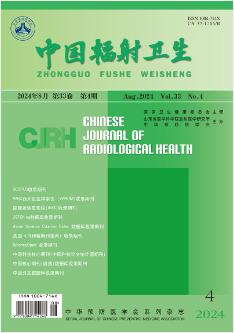CT和SWI评估糖尿病合并高血压患者CMBs发生的临床价值
引用次数: 0
摘要
目的通过计算机断层扫描(CT)和敏感加权成像(SWI)检查,分析比较对照组、糖尿病组、高血压组和糖尿病高血压组脑内微出血(CMBs)的发生率和流行部位。探讨CMBs发病的危险因素,为CMBs的临床诊断和治疗方案的选择提供依据。方法收集2019年5月~ 2020年10月山东省电力中心医院神经内科非急性病患者174例,其中男性101例,女性73例,年龄45 ~ 89岁,平均年龄72±5岁。根据疾病类型分为四组:高血压合并2型糖尿病组、高血压组、2型糖尿病组、对照组(无高血压、2型糖尿病)。所有患者均行CT和MRI SWI序列扫描。4组患者性别、年龄匹配,排除性别、年龄的影响。统计四组CMBs的发生率、数量及分布,分析比较四组CMBs的CT及SWI影像学表现。结果CT未发现患者脑内CMBs的发生。SWI成像显示,174例患者中有58例(发病率33.3%)检出CMBs,其中糖尿病合并高血压组24例(发病率57.1%)检出CMBs。高血压组21例(发病率46.7%),糖尿病组8例(发病率22.2%),对照组5例(发病率9.8%)。高血压组、糖尿病合并高血压组CMBs发生率均显著高于对照组(P < 0.05)。单纯性糖尿病患者的CMBs发生率与对照组相比无显著差异。糖尿病合并高血压组与单纯性高血压组的CMBs发生率无显著差异。结论CT未发现非急性期患者脑内CMBs的发生。SWI能清晰显示入组患者的CMBs。糖尿病不太可能引起CMBs的增加。高血压与CMBs的发生有显著关系。与高血压或/和糖尿病相关的CMBs多见于基底节区和丘脑,不同于脑淀粉样血管病,这为临床治疗方案的选择提供了依据。摘要:目的借助电子计算机断层扫描(CT)和磁敏感加权成像(瑞士)检查,分析比较对照组,糖尿病组,高血压病组及糖尿病合并高血压病组患者伴发脑内微出血(CMBs)的发生率及好发部位,探讨CMBs发病危险因素,以期为CMBs临床诊疗方案选择提供依据。方法 搜集山东电力中心医院2019年5月一2020年10月神经内科住院非急性 期病人174例, 其中男性101例, 女性73例, 年龄45〜89岁, 平均年龄(72 ± 5)岁。按病种分为4组:高血压病合并 2型糖尿病组、高血压病组、2型糖尿病组、对照组(无高血压病及2型糖尿病)。(4)、(4)、(4)、(3)统计4组患者CMBs发生率,数目,分布部位,分析比较4组患者CMBs的CT和瑞士影像学表现。结果CT未发现患者脑内CMBs发病情况,瑞士影像学显示174例患者中有58例出现CMBs(发生率33.3%),糖尿病合并高血压组24例发生CMBs(发生率为57.1%),高血压组21例发生CMBs(发生率为46.7%),糖尿病组8例发生CMBs(发生率为22.2%),对照组5例发生CMBs(发生率为9.8%)。高血压病组及糖尿病合并高血压组比对照组CMBs发生率明显增加(P < 0.05),单纯糖尿病患者比对照组CMBs发生率无明显差别,糖尿病合并高血压组CMBs发生率与单纯高血压组比较无明显差别。结论CT没有发现非急性期病人患者脑内CMBs发病情况,瑞士能清晰显示入组患者CMBs情况,糖尿病导致CMBs增多的可能性较小,高血压病与CMBs发生显著相关,高血压病或/和糖尿病患者伴发CMBs常见于基底节及丘脑部位,与脑淀粉样血管病不同,为临床治疗方案的选择提供了依据。本文章由计算机程序翻译,如有差异,请以英文原文为准。
The clinical value of CT and SWI in evaluating the occurrence of CMBs in diabetic patients with hypertension
Objective With the help of computerized tomography (CT) and susceptibility-weighted imaging
(SWI) examinations, to analyze and compare the incidence and the prevalent sites of
microbleeds (CMBs) in control group, diabetes group, hypertension group and diabetic
hypertension group with intracerebral CMBs. The risk factors for the onset of CMBs
also will be explored, in order to provide a basis for the selection of clinical diagnosis
and treatment options for CMBs.
Methods A collection of 174 non-acute patients in the Department of Neurology of Shandong
Electric Power Central Hospital from May 2019 to October 2020, including 101 males
and 73 females, aged 45–89 years, with an average age of 72 ± 5 years. Divided into
four groups according to disease types: Hypertension with type 2 diabetes group, Hypertension
group, Type 2 diabetes group, Control group (no hypertension and type 2 diabetes).
All patients underwent CT and MRI SWI sequence scans. The 4 groups of patients were
matched in terms of gender and age, excluding the influence of gender and age. The
incidence, number and distribution of CMBs in the four groups were counted, and the
CT and SWI imaging manifestations of CMBs in the four groups were analyzed and compared.
Results CT did not find the incidence of CMBs in the brain of patients. SWI imaging showed
that CMBs were detected in 58 of 174 patients (incidence rate 33.3%), and CMBs occurred
in 24 cases of diabetes and hypertension group (incidence rate 57.1%). CMBs occurred
in 21 cases in the hypertension group (incidence rate 46.7%), 8 cases in the diabetes
group (incidence rate 22.2%), and CMBs occurred in 5 cases in the control group (incidence
rate 9.8%). The incidence of CMBs in the hypertension group and the diabetes combined
with hypertension group was significantly higher than that in the control group (
P < 0.05). There was no significant difference in the incidence of CMBs in patients
with simple diabetes compared with the control group. Also, there was no significant
difference in the incidence of CMBs between the diabetes combined with hypertension
group and the simple hypertension group.
Conclusion CT did not find the incidence of CMBs in the brains of patients in the non-acute
phase. SWI could clearly show the CMBs of the enrolled patients. Diabetes is less
likely to cause an increase in CMBs. Hypertension is significantly related to the
occurrence of CMBs. CMBs associated with hypertension or/and diabetes are common in
the basal ganglia and thalamus, which is different from cerebral amyloid angiopathy,
which provides a basis for the choice of clinical treatment options.
摘要: 目的 借助电子计算机断层扫描(CT)和磁敏感加权成像(SWI)检查, 分析比较对照组、糖尿病组、高血压病组 及糖尿病合并高血压病组患者伴发脑内微出血 (CMBs)的发生率及好发部位,
探讨CMBs发病危险因素, 以期为 CMBs临床诊疗方案选择提供依据。
方法 搜集山东电力中心医院2019年5月一2020年10月神经内科住院非急性 期病人174例, 其中男性101例, 女性73例, 年龄45〜89岁, 平均年龄(72 ±
5)岁。按病种分为4组:高血压病合并 2型糖尿病组、高血压病组、2型糖尿病组、对照组(无高血压病及2型糖尿病)。所有患者均行CT和MRI SWI序列扫 描, 4组患者性别、年龄方面差异无统计学意义。统计4组患者CMBs发生率、数目、分布部位,
分析比较4组患者 CMBs的CT和SWI影像学表现。
结果 CT未发现患者脑内CMBs发病情况, SWI影像学显示174例患者中有 58例出现CMBs(发生率33.3%), 糖尿病合并高血压组24例发生CMBs(发生率为57.1%),
高血压组21例发生 CMBs(发生率为46.7%), 糖尿病组8例发生CMBs(发生率为22.2%), 对照组5例发生CMBs(发生率为9.8%)。高血 压病组及糖尿病合并高血压组比对照组CMBs发生率明显增加
(
P < 0.05), 单纯糖尿病患者比对照组CMBs发生率无 明显差别, 糖尿病合并高血压组CMBs发生率与单纯高血压组比较无明显差别。
结论 CT没有发现非急性期病人患 者脑内CMBs发病情况, SWI能清晰显示入组患者CMBs情况, 糖尿病导致CMBs增多的可能性较小, 高血压病与 CMBs发生显著相关,
高血压病或/和糖尿病患者伴发CMBs常见于基底节及丘脑部位, 与脑淀粉样血管病不同, 为临 床治疗方案的选择提供了依据。
求助全文
通过发布文献求助,成功后即可免费获取论文全文。
去求助
来源期刊
CiteScore
0.80
自引率
0.00%
发文量
7142
期刊介绍:
Chinese Journal of Radiological Health is one of the Source Journals for Chinese Scientific and Technical Papers and Citations and belongs to the series published by Chinese Preventive Medicine Association (CPMA). It is a national academic journal supervised by National Health Commission of the People’s Republic of China and co-sponsored by Institute of Radiation Medicine, Shandong Academy of Medical Sciences and CPMA, and is a professional academic journal publishing research findings and management experience in the field of radiological health, issued to the public in China and abroad. Under the guidance of the Communist Party of China and the national press and publication policies, the Journal actively publicizes the guidelines and policies of the Party and the state on health work, promotes the implementation of relevant laws, regulations and standards, and timely reports new achievements, new information, new methods and new products in the specialty, with the aim of organizing and promoting the academic communication of radiological health in China and improving the academic level of the specialty, and for the purpose of protecting the health of radiation workers and the public while promoting the extensive use of radioisotopes and radiation devices in the national economy. The main columns include Original Articles, Expert Comments, Experience Exchange, Standards and Guidelines, and Review Articles.

 求助内容:
求助内容: 应助结果提醒方式:
应助结果提醒方式:


